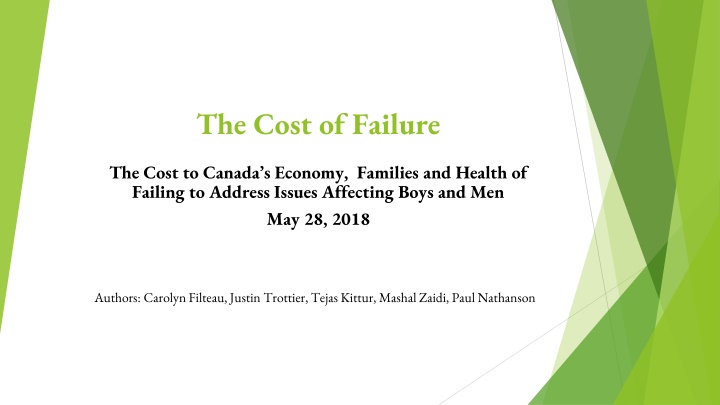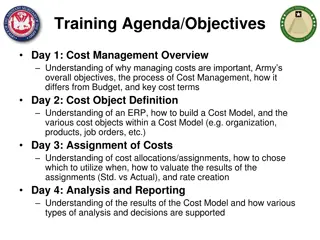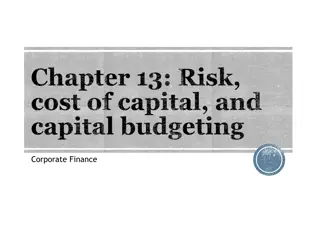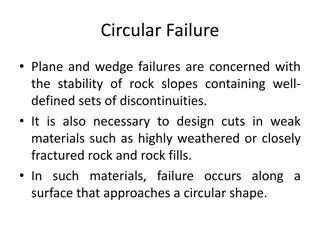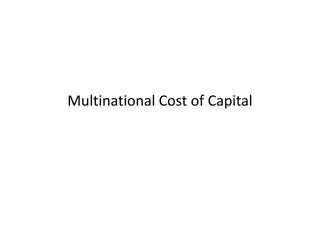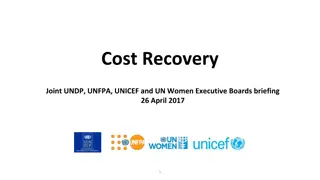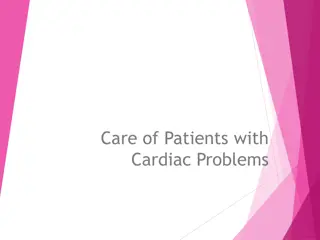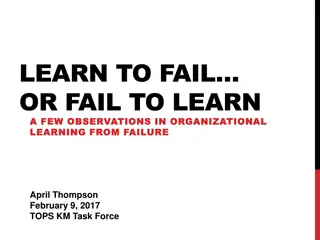The Cost of Failure
This report delves into the negative consequences of neglecting issues impacting boys, men, and fathers on the economy, families, and health in Canada. It explores the correlation between education, economic prosperity, and national growth, advocating for solutions to tackle these challenges.
Download Presentation

Please find below an Image/Link to download the presentation.
The content on the website is provided AS IS for your information and personal use only. It may not be sold, licensed, or shared on other websites without obtaining consent from the author.If you encounter any issues during the download, it is possible that the publisher has removed the file from their server.
You are allowed to download the files provided on this website for personal or commercial use, subject to the condition that they are used lawfully. All files are the property of their respective owners.
The content on the website is provided AS IS for your information and personal use only. It may not be sold, licensed, or shared on other websites without obtaining consent from the author.
E N D
Presentation Transcript
The Cost of Failure The Cost to Canada s Economy, Families and Health of Failing to Address Issues Affecting Boys and Men May 28, 2018 Authors: Carolyn Filteau, Justin Trottier, Tejas Kittur, Mashal Zaidi, Paul Nathanson
OVERVIEW This report seeks to illustrate how the lack of attention to the issues affecting boys, men and fathers, and the lack of services for boys, men and fathers, results in significant negative consequences on society. The discussion is divided into three broad categories: (1) The impact on our Economy (2) The impact on Families and Youth and (3) The impact on the Health of Men. Following this overview of the problems and their consequences, we will then describe some possible solutions to these problems as well as organizations in the community working to implement these solutions.
Part 1: The Issues (1) The impact on our Economy (2) The impact on Families and Youth and (3) The impact on the Health of Men
Part 2: Solutions (1) The impact on our Economy (2) The impact on Families and Youth and (3) The impact on the Health of Men
(1) The Impact on our Economy a) Boys and the Educational System The correlation between increased level of education and economic prosperity is well established. The bridge that connects education and economic prosperity is twofold. Figure 1: The chart demonstrates that individuals with a university degree in Canada earned $165 for every $100 earned by high-school graduates. Those with a college degree earned $110 for every $100 earned by high-school graduates, and those who did not graduate from high school earned only $80 for every $100 earned by high school graduates.
Figure 2 demonstrates a link between higher rates of educational attainment and both increased wages and reduced chances of becoming unemployed
(1) The Impact on our Economy a) Boys and the Educational System Secondly, education targets the supply side by improving the productivity in human capital and technological advancement. In turn, this positively correlates to an increase in national economic growth.
(1) The Impact on our Economy a) Boys and the Educational System A mountain of evidence therefore demonstrates that education is key both to individual financial success and to a state s economic growth. Compared to their female counterparts, boys and young men score worse across the board in literacy and writing, display significantly more severe behavioral problems and are far more likely to drop-out of high school. Men are under-enrolling compared to women in universities across all developed countries. Yet there is a lack of concrete policy solutions to address this issue.
(1) The Impact on our Economy a) The Changing Job Market Despite significant labour mobility in Canada, Canadian firms are having more difficulty in hiring than the general unemployment situation would suggest. By 2020, it is estimated that Canada will be short one million workers. In the manufacturing sector alone, 400,000 workers will be required in the next 15 years due to retirement alone. By 2007, more than one-third of jobs created in Canada will require trade certification or a college diploma
Chart 1: Registered apprenticeship by sex and provinces and territory 2011 2012 2013 2014 2015 number Canada 426,285 444,672 469,680 451,140 453,543 Males 367,737 381,432 403,572 389,253 392,559 Females 58,545 63,240 66,111 61,890 60,984 Ontario 153,918 164,562 172,686 144,909 146,439 Males 117,285 124,641 132,024 110,628 114,459 Females 36,633 39,921 40,662 34,278 31,980
(2) The Impact on Families and Youth a) Fatherlessness Fatherlessness has a serious negative impact on families and youth and contributes to a host of social problems. Widespread research has demonstrated the many negative psychological and social effects of fatherlessness on children. Children who are deprived of fathers lose out across a wide range of metrics, including emotional well-being, financial security and health outcomes.
(2) The Impact on Families and Youth a) Fatherlessness i. The Consequences of fatherlessness Below are a few examples. These were drawn from US sources since the United States has far more comprehensive data in this area: 63% of youth suicides are from fatherless homes, a rate that is five times the national average (U.S. Dept of Health/Census); 70% of youths in state-operated institutions come from fatherless homes (U.S. Dept of Justice); 71% of all high school dropouts come from fatherless homes (National Principals Association Report); 85% of all children who show behavioral disorders come from fatherless homes (Center for Disease Control);
(2) The Impact on Families and Youth a) Fatherlessness i. The Consequences of fatherlessness Studies have found that fatherless youth are more likely to be victims of exploitation and abuse, and father absence through divorce is strongly associated with diminished self-concepts in children (Parish, 1987). Furthermore, fatherlessness results in youth being four times more likely to be raised in poverty.10 The health consequences caused by poverty are further articulated in the sections below A study undertaken by University of British Columbia Associate Professor Edward Kruk found that sole maternal custody often leads to parental alienation and father absence, and father absence is associated with negative child outcomes.
(2) The Impact on Families and Youth a) Fatherlessness ii. The reasons for fatherlessness There are many causes for fatherlessness In many cases, fathers are willfully excluded and prevented from having contact with children by ex-partners and the current legal system Little effort is made to support healthy and strong father-child relationships. While economic support is very important, social and emotional support to a child s development and wellbeing is essential. There is evidence to suggest that fathers are being treated unfairly by the legal system governing divorce and child custody.
(2) The Impact on Families and Youth a) Fatherlessness iii. Parental Alienation Parental alienation is the term used when a child unreasonably rejects one parent as the result of conscious or unconscious negative influence by another. The alienating parent cultivates an attitude of obsessive hostility in the child towards the alienated parent. usually extends to that parents entire family one parent frequently uses the child as a weapon to hurt the other parent the father is far more frequently the alienated parent. A case where a child naturally prefers one parent to another, of course, does not count as pathological alienation. Parental Alienation Syndrome is not expected to extend to fathers who are legitimately abusive or demonstrably unfit.
(2) The Impact on Families and Youth b) Violence Against Men i. General violence In Canada, men make up 75 percent of all homicides Men account for 60 percent of all robbery victims. Men are three times more likely to suffer aggravated assault and twice as likely to be assaulted with a weapon. Men are three times more likely to be assaulted in public places and are more likely to be harmed by a stranger or acquaintance. Ninety-five percent of the prison and criminal justice population is male and men experience additional violence in prison, with homicide and assault rates significantly higher in prison.
(2) The Impact on Families and Youth b) Violence Against Men ii. Domestic violence Victims of domestic violence span all ages, all races, all ethnicities, and all socioeconomic groups as well as all sexual orientations and all genders Violence is a reality within gay and lesbian relationships, and it also happens to men within heterosexual relationships. It is important that we find ways to break through social norms and other barriers which prevent any individual who has experienced violence from coming forward. Men experience violence from women while in romantic partnerships. The 2014 General Social Survey on Family Violence, which provides the most recent data on the topic of domestic abuse, concluded as follows: In 2014, equal proportions of men and women reported being victims of spousal violence during the preceding 5 years (4%, respectively). This translated into about 342,000 women and 418,000 men across the provinces.
(2) The Impact on Families and Youth b) Violence Against Men ii. Domestic violence Significantly more men than women were dissatisfied with the police response when they reported the incidents. The Partner Abuse State of Knowledge Project concluded that women perpetrate physical and emotional abuse, as well as engage in control behaviors, at comparable rates to men According to research by Denise A Hines and Emily M. Douglas, published in the US National Library of Medicine barriers for men to leave abusive relationships are similar to those for women.
(2) The Impact on Families and Youth b) Violence Against Men ii. Domestic violence Barriersinclude: 1. acommitmenttothemarriage, 2. alackof financialresources,and 3. aconcernfor theirchildren.
(2) The Impact on Families and Youth b) Violence Against Men ii. Domestic violence Financial stability is critical for victims of domestic violence to find safety and gain independence from their abusers. The severity of domestic violence on the victim s personal economic situation as well as costs to society and third parties is extreme. A study on domestic violence by Moe and Bell (2004), found that victims of domestic violence had difficulty finding or maintaining work because of fear, anxiety, physical injuries, emotional trauma, and the need for safety. Due to the similarities in victimization, men experience all of the above barriers in addition to experiencing a struggle to maintain a masculine ideal, an ideal that expects them to be self-reliant and independent (Lupri & Grandin, 2004) The failure to take seriously domestic violence against men leads to treatment programs for victims of abuse that are based on gender paradigms
(2) The Impact on Families and Youth b) Violence Against Men iii. Sexual violence against men Sexual violence is usually about power and control. Sexual violence committed against men and boys is largely unreported and in some cases unknown due to the stigma attached to sexual violence for men. It is estimated that 1 in 6 boys and men have been sexually abused or assaulted, amounting to almost one million Ontarian men. In juvenile Correctional facilities such as those run by the province, both men and women have power over boys: the current juvenile residential jail system is a place where young boys areroutinelysexually assaulted by bothmale and femalesupervisors.
(3) The Impact on the Health of Men a) Male Risk Factors Some of the factors putting men at high risk include: Men make one half as many physician visits for prevention; Men are employed in the most dangerous occupations, such as mining, firefighting, construction and fishing; Society fails to emphasize healthy behaviors in men and boys; Research on male-specific diseases is underfunded; and Men may have less healthy lifestyles including risk-taking at younger ages Men are heavier smokers than women, smoking an average of 3 more cigarettes per day than women. Todd, Douglas Fentanyl deaths: 4 of 5 are males, mostly young Vancouver Sun December 30, 2016
(3) The Impact on the Health of Men a) Male Risk Factors Men have a higher death rate for most of the leading causes of death: Cancer, Injuries (unintentional), Chronic lower respiratory disease, Cerebrovascular disease, Diabetes, Alzheimer s, Pneumonia/flu, Suicide, Homicide, HIV infection In Canada, 65% of men between the ages of 30 to 64 are overweight or obese, almost fifty percent are inactive, over forty percent binge drink and twenty-six percent smoke (Canadian Men s Health Foundation, 2018). Compared to women, men are 40% more likely to die from cancer and 70% more likely to die from heart disease. Men live an average of 9 years of their lives in extremely poor health (Canadian Men s Health Foundation, 2018). The tragedy and also the opportunity is that an estimated 70% of men s health problems are preventable through public consciousness
(3) The Impact on the Health of Men b) The Cost to Poor Male Health According to a study on Ontario s health care system, high cost users (HCU) tend to be overweight or obese, former smokers, physically inactive, and current non-drinkers. Within this group men are overrepresented. In addition, full-time employment is seriously affected by health, with persons who use medical resources intensively those less able to hold a full-time job. The problem of the higher burden on the healthcare system is compounded by a reduced income tax base to support these costs. Crucially, it is men, who still make up a larger fraction of the workforce, who are also more likely to face reduced employment as a result of poor health. The implications of an unhealthy population, especially men, can have a detrimental effect on the national GDP in terms of lost human and financial capital.
(3) The Impact on the Health of Men b) The Cost to Poor Male Health Findings from a public health nutrition study (2003) found that when household food expenditure patterns were compared between low-income and higher-income households, low-income households incorporated fewer servings of healthy foods into their family s diet as compared with higher-income households, even when other factors were held constant (Kirkpatrick & Tarasuk, 2003) Such results suggest that low-income households are more prone to illness and therefore more likely to miss work. In conclusion we can find lower educational attainment leading to lower income levels and from there to poorer health outcomes and to intergenerational cycles of poverty.
(3) The Impact on the Health of Men c) Suicide A major preventable cause of death among men is suicide. In Canada, men consistently commit suicide at 3 to 4 times the rate of women. There are 6 major causes for suicide that often intersect and overlap: mental illness, addiction, marital/relationship breakdown, financial hardship, physical health problems and a major loss. Cutting across and exacerbating all these causes is the way in which men are socialized to suppress their emotions and to be a man. Having children reduces the occurrence of suicide for women but not for men. It is likely that if men were more connected and involved with their children s lives there could be reduced incidences of suicide. Childhood sexual abuse may also be a highly significant but largely unreported factor in male suicide.
(3) The Impact on the Health of Men c) Suicide North American men going through divorce are eight times more likely than divorcing women to commit suicide, according to a report by Augustine Kposowa of the University of California, Riverside. Kpsowa found that while social, psychological and personal problems facing women are readily denounced, societal institutions tend to ignore or minimize male problems that are evident in suicide statistics. Professor John Oliffe of the UBC-based Men s Health Research agency reached a similar conclusion: Divorce is a classic factor in suicide. These men become socially isolated. There are so many examples of good men s lives ending prematurely. The majority of studies suggest that men are at a greater risk of suicide than women in the aftermath of relationship breakdown.
(3) The Impact on the Health of Men c) Suicide Single adult males between the ages of 25 and 55 account for almost half of the homeless population in Canada (47.5%), according to the Segaert study. The characteristics of this group include greater incidences of mental illness, addictions and disability, including invisible disabilities such as brain injury and PTSD. Since single adult males form a large percentage of the chronically homeless, efforts targeting this population are warranted. Research clearly proves that it costs society more to leave a person homeless than it does to provide housing support.
(3) The Impact on the Health of Men c) Homelessness There are healthcare costs that must be included in this analysis. The resources of hospitals in downtown areas are heavily burdened by the needs of the homeless who usually have no family doctor and little in the way of preventative healthcare. The total annual cost in Canada of homelessness is estimated at $7 billion. Given the disproportionate representation of homeless men in Canada, Canada would yield a net benefit by focusing on issues of male homelessness (Londerville and Steele, 2014).
(1)The Impact on our Economy a) Boys and the Educational System i. Corporations and Professional Associations We recommend career recruitment programs that encourage young men to consider careers in professions in which men are currently underrepresented, including the following disciplines: nursing healthcare social service sector teaching early childhood education human resources public relations veterinarians
(1)The Impact on our Economy a) Boys and the Educational System ii. Parents The Dr. Eric Jackman Institute of Child Study at the University of Toronto is looking at how the life chances of the next generation can be improved. Plotnik maintains that students who are achievers have a number of common characteristics that are developed in children largely through appropriate parenting practices Achievers tend to have: 1. 2. 3. Come from more stimulating home environments where parents speak and read to them more. 4. Work harder, not only because of the need to succeed, but also because they enjoy what they are doing. Higher self esteem and confidence Have received more support from parents, teachers and society in general
(1)The Impact on our Economy a) Boys and the Educational System ii. Parents Parents must also be involved in the school system and share their vision of excellence with the teacher. They can also insist schools work towards a gender balance in teachers and insist on appropriate learning materials. Boys are far more likely to be singled out with behavioural problems, learning disorders or prescribed psychotropic drugs. In studying the hyperactivity of boys, former Ontario teacher, principal and school superintendent Dr. James Brown has concluded that parents
(1)The Impact on our Economy a) Boys and the Educational System ii. Parents In studying the hyperactivity of boys, Dr. James Brown has concluded that parents should challenge the school s haste to identify their sons as learning disabled or as having attention deficit/hyperactivity disorder, when they are simply active boys behaving as their parents have raised them to behave. They should insist on a second opinion before allowing teachers to pressure them into asking their family physician to prescribe drugs for their sons so that the teachers can continue to use teaching methods unsuitable for active boys. (Brown, 285)
(1)The Impact on our Economy a) Boys and the Educational System iii Ministry of Education 1. Address the problem with boys as soon as they enter the educational system, especially with regards to literacy. 2. Consider modifying the means by which we evaluate and report on student progress, especially in the earlier years of schools. 3. Improve the gender balance in school teachers, especially among earlier grade teachers 4. Endeavour to make primary education more accepting and friendly to boys. This does not mean orienting it away from the needs of girls.
(1)The Impact on our Economy a) Boys and the Educational System iv. Teachers Teachers should consider founding a boys club in their high school, modeled on the successful group currently operating under the direction of teacher John Mason at Port Credit Secondary School in Mississauga. Recognize and address a boy s lack of engagement with school as early as possible by finding creative ways to reach each student. Many boys feel marginalized and as a result are disengaged.
(1)The Impact on our Economy a) Boys and the Educational System v. Universities/Colleges Create male studies departments at universities and colleges in order to foster research in this area. vi. Corporations and Non-profits Sponsor graduation awards for most improved boys. As a pilot project in 2018 the educational charity Canadian Association for Equality will be sponsoring an award of $500 for each school in Peel Region to be given to one grade nine boy who has shown the greatest improvement in their overall average compared to the previous year.
(1) The Impact on our Economy b) The Changing Job Market Male-dominated industries are disappearing, leaving behind a pool of unemployed or underemployed men with largely non-transferable skills. In just the past four years, nearly 70,000 jobs were lost in the manufacturing and agriculture sectors combined across the country. Nearly 200,000 jobs were created in the health care and social service industries over the past four years in Canada. Yet in 2016, only 10% of registered nurses and 12 percent of health care aides were men. It is time to develop male-focused recruitment programs to bring men into traditionally female-dominated disciplines.
(2) The Impact on Families and Youth a) Fatherlessness i. Equal Parenting legislation The single most effective action that will bring fairness to our family law system and provide a framework for decisions in the best interest of the child is to advance equal parenting legislation. The federal government should amend the Divorce Act so that children can benefit from vibrant, loving and full relationships with both their parents after separation or divorce. The new framework would establish a rebuttable presumption of equal parenting following family break-up, in which both parents maintain equal rights and responsibilities with their children. Prior to divorce or separation, a child needs and benefits from a strong relationship with both parents. Divorce does not change that fact.
(2) The Impact on Families and Youth a) Fatherlessness ii. Prioritize Arbitration and Mediation We can substantially reduce the costs to our overburdened family court system, and to the legal expenses of individual citizens, by shifting our emphasis to arbitration and mediation in family law. Mandatory Mediation -Must for today's world. iii. Community Fathering Programs We should invest in community programs that promote father involvement, such as the Fathering after Separation or Divorce program at the Canadian Centre for Men and Families.47 This program provides a broad range of knowledge, resources and skills for fathers looking to maintain a strong relationship with their children following a divorce or separation.
(2) The Impact on Families and Youth a) Fatherlessness iv. Attitudes Toward Fathering Change our attitudes toward fatherhood. Fatherhood should be praised and encouraged as a source of pride and meaning for fathers, and the role of men solely as bread winner needs to be challenged directly. v. Amend the Income Tax Act The federal government should revise the Income Tax Act so it stops withholding the Canada Child Benefit from low income fathers. The Income Tax Act currently presumes the mother is the child s primary caregiver, whatever the circumstances.
(2) The Impact on Families and Youth b) Violence Against Men i. Open shelters and crisis services for abused men and their children: Imagine you and your child live each day in fear of violence, but no one believes you because you're a man. That is the situation for thousands of fathers every year.
(2) The Impact on Families and Youth b) Violence Against Men Research by Dr. Emily Douglas and Dr. Denise Hines into help-seeking behaviours of male victims concludes that male victims do in fact engage in help-seeking behaviours. In fact, 43.7% of male victims contacted a domestic violence agency, 23.4% contacted a hotline and 66.2% reached out to a mental health professional. But at the same time, research demonstrates the inadequacy of how these men were treated: The conclusion of their research is remarkable: results indicate that men who seek help for IPV victimization have the most positive experiences in seeking help from family/friends, and mental health and medical providers. They have the least positive experiences with members of the DV service system. I
(2) The Impact on Families and Youth b) Violence Against Men The conclusion, that men will seek help but that help is often not available or not receptive to men as victims, makes a strong case for a campaign to open emergency services, including domestic violence shelters, dedicated men and their children, while educating the existing victim service agencies so they can do a better job for all families in crisis. The result would be an improvement in the health and well-being of men and their children, While most of the research cited above was conducted in the United States, there is no reason to believe the situation is different for male victims in Canada.
(2) The Impact on Families and Youth b) Violence Against Men Men cannot simply flee to a shelter for single homeless men. They require access to a family shelter that will accommodate them and their children and where they can access services appropriate to their situation as victims of violence. We now know the long-term effects on children of growing up in an abusive home are severe, including behavioural effects such as aggression and delinquency, and psychological effects such as anxiety, depression and low self-esteem 52 and greater likelihood that, as adults, they will become involved in abusive marital relationships. There are reasons for optimism. Around the world, social service agencies are stepping up.
(2) The Impact on Families and Youth b) Violence Against Men ii. Hospital screening programs that are gender inclusive All Ontario hospitals have a screening program to determine if women entering the hospital are victims of domestic abuse. While a few hospitals, such as St. Michael s in Toronto, may also ask men, there is no policy requiring that they do so. The province of Alberta made gender inclusive screening programs for domestic violence mandatory in 2014 and other provinces should follow their progressive lead.
(2) The Impact on Families and Youth b) Violence Against Men iii. Police should apply common investigative policies for male and female victims It is often the case that conclusions about gender and family violence are built entirely on police data. That is why many people think female victims constitute 80% of all victims of domestic violence. When we dig a little deeper, we realize that police data are wildly inconsistent with virtually every other measure of domestic violence Here s how to make sense of this paradox. Police statistics on domestic violence are unreliable because protocols police are required to follow are bound by an ideological commitment which dismiss women as possible perpetrators of violence or make it far less likely that a woman will be charged with this crime.
(2) The Impact on Families and Youth b) Violence Against Men The manualA Handbook for Police Responding to Domestic Violence is a resource for the Ontario Provincial Police and the Toronto Police It encourages police to base their investigations on dangerous stereotypes which put men and their children in danger. Domestic violence risk assessment tools which are used by police agencies across Canada frequently employ different procedures depending solely on the gender of the victim and the perpetrator. We recommend police policies and procedures follow the weight of evidence and investigate domestic violence incidents in a manner that supports all victims of abuse and protects all children at risk.
(2) The Impact on Families and Youth b) Violence Against Men iv. Victim Service agencies should provide the same support to male and female victims Victim Service agencies should provide the same range of support services to male and female victims. These services include emergency crisis counselling, long-term trauma-informed psychotherapy, legal aid, case management to assist with reports to the Children s Aid Society and other organizations, and priority access to affordable housing.
